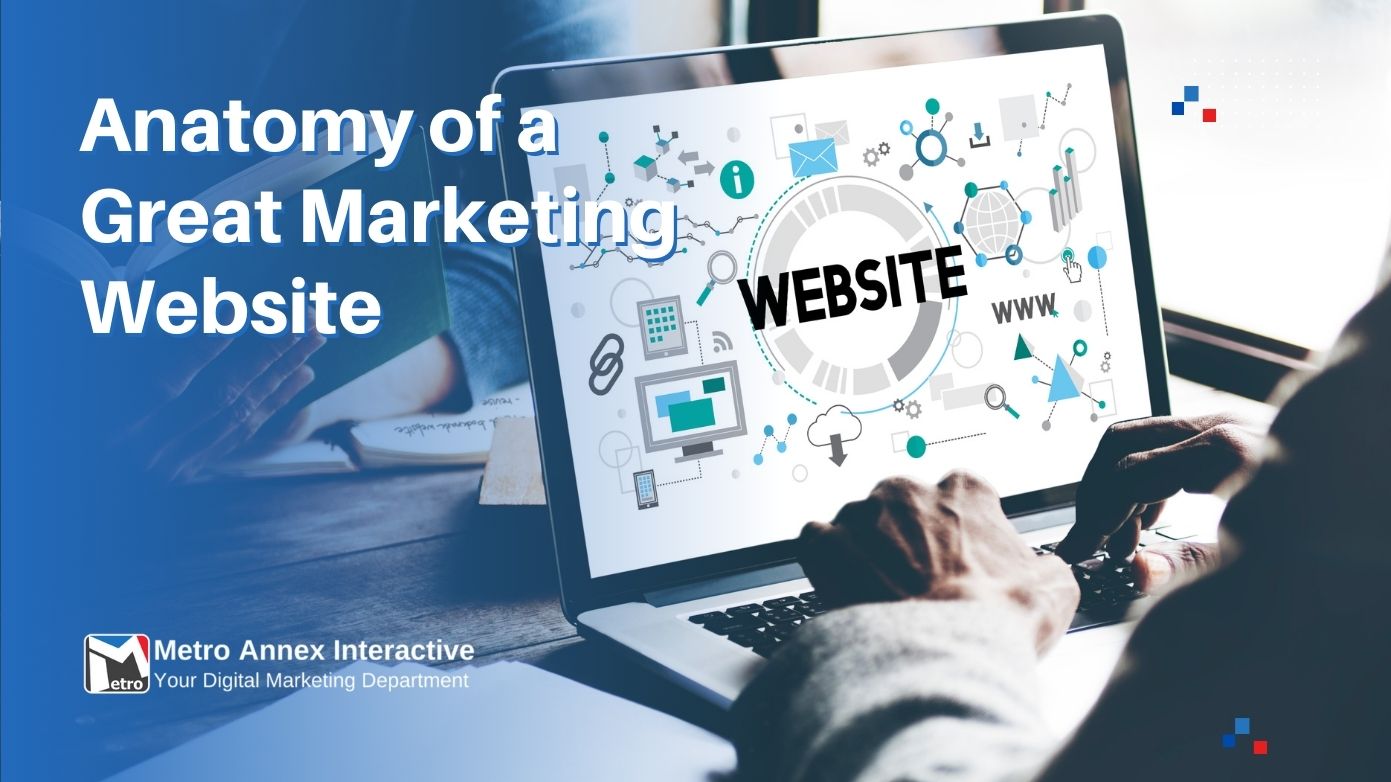Marketeering Blog
Anatomy of a Great Marketing Website

In today’s digital business world, your website is the hub of your marketing campaign. It’s the first impression potential customers will have of your business. And, as you know, first impressions are everything. A blah, hard-to-navigate website is an instant turnoff that will surely drive away visitors in droves. We’re going to explore the anatomy of a great marketing website and show you how it can be eye-catching while being functional, and above all, draw customers to your business.
How Does Your Website Rank?
While you may have a glitzy website, it doesn’t mean it’s ranking in searches. There is a saying: “a beautiful exterior doesn’t guarantee a healthy interior.” This applies to humans, houses, and yes, websites!
You could have the most appealing layout design, but, if it’s not properly coded or contains specific keywords related to your business, potential customers will never see it.
The goal for any business website is for it to show up on that first search results page. Let’s say someone is searching for a plumber. When they type in “plumber” in the search bar, a list of plumbers will populate on a results page.
There are likely numerous subsequent pages listing scores of plumbers, but let’s face it, the majority of people are going to choose one from that first page. And they are likely to choose one near the top of the page.
So, how do you get your website to show up not only on that first search results page, but near the top? It’s all about having the right technology incorporated into your business website. And creating an effective website marketing strategy.
RELATED ARTICLE: Using Technology for Marketing Your Business
Website Technologies

You likely know about SEO (Search Engine Optimization). This is about having a website designed to include proper technologies so your keywords meet SEO protocol to get your website ranked right up there.
Search engines use spider bots that “crawl” the internet. Typically, a website has a sitemap that has pertinent information about the pages, the content, and when it was updated. The bots use this information to provide seamless transition from page to page. Any errors can throw a roadblock on your site.
A properly designed marketing website must contain specific metadata. This includes:
- Page Title – Your business name, your target city/state, keywords (i.e., your product or service).
- Meta Description – A brief description about your company and keywords related to your business. Here’s an example: Acme Plumbing, Yourtown, MA. We have 30 years of experience providing expert, reliable plumbing services including 24/7 emergency service in the Yourtown, Massachusetts area.
- Analytics – Make data-driven decisions on improving your business and increasing you ROI (Rate of Return) by collecting information on your website such as what visitors are looking at, what they are buying, what brings them to your site.
- CRM (Customer Relationship Management) – Manage your relationships and interactions with existing and potential customers with this technology that provides information to help you optimize marketing campaigns and strategies.
- Mobile Friendly – Your website must be designed to be viewed on mobile devices (tablets and smartphones) as well as desktops and laptops.
- Image Sizes – Images must be optimized to fit the screens of mobile and desktop devices and to allow a fast load time. Images that are too large will slow down the loading of a webpage. Google notes that a page that takes 5 seconds or longer to load has a 90% likelihood the visitors will leave.
- Fast Loading – As mentioned above, your website and its pages must load fast to avoid losing visitors.
- On-Page Content – High-quality content, target keywords, links, and title tags are vital for optimized on-page content to get more search engine content.
Driving Traffic Your Website
As part of your digital marketing strategy, you not only want your website to rank high in search results, but you also want to drive traffic to your website and engage visitors. There are many ways to accomplish this.
1. Chat – According to Techjury, 75% of website visitors prefer chat over any other communication channel. It’s a great way to engage a visitor who may be on the verge of purchasing your product or service by quickly answering a question they may have. There are several chat options that can be added to your site.
2. Opt-Ins – This is a form a visitor can fill out to request information or to sign up for email newsletters. These forms can be added on landing pages, product/service pages, or pop-ups. Since you have their contact info, you can begin a retargeting campaign.
3. Retargeting – This is a way to contact someone who has visited your website and expressed interest in your business by providing their contact information or viewed your product/service pages. There are two types of retargeting: pixel and list based. Pixel retargeting is when a piece of code known as a cookie is placed on a visitor’s browser that will display ads from the page they visited as they surf the web. List based is using contact info the visitor provided allowing you a customized sales approach.
4. Quizzes – Create a short quiz as an interactive marketing tool. Ask visitors to your site several questions about a particular subject and include a lead capture form to get their contact info so you can contact them.
5. Appointment booking – Provide a form so visitors can schedule an appointment with you.
6. Remarketing – Using email and ads to convince potential or existing customers to give your business a second look.
RELATED ARTICLE: Remarketing Your Potential and Existing Customers
Website Traffic Sources

There are several ways to drive traffic to your website.
- Advertising – Be it digital (paid advertising, billboard advertising, Google advertising) or traditional (Flyers, mailings, print) advertising, you need to get the word out about your business.
- Search – SEO is one of the best ways to drive market-qualified traffic to your website. A good content marketing strategy along with an SEO process will drive large amounts of organic traffic from Google, Bing, and other search engines.
- PR (Public Relations) – Improve the visibility and reputation of your business through a public relations campaign that includes digital, mailings, or print communications.
- Social Media – Social media marketing is great for brand awareness. Facebook, Twitter, LinkedIn are among the top channels to spread the word about your brand and engage prospects and customers.
- Keyword Research – This is finding search terms that people enter into search engines for a particular service or product. It’s important to use variations of particular terms to make sure all bases are covered when it comes to a specific search. Conducting keyword research is a vital part of search engine marketing.
- Events – Create a webinar or networking event to provide value to potential customers and brand awareness.
- Out-of-the Box Campaigns – Social media platforms, PPC campaigns, and paid ads are great to attract customers, but so is a marketing campaign that stretches the imagination, like a shock and awe campaign. Here at Metro Annex, we sent out gift boxes of hot sauce to potential and existing customers; not something anyone would expect from a marketing agency. But it worked! Curious people opened the boxes and were impressed by a clever marketing strategy. Curiosity is a human trait that can’t be overcome.
RELATED ARTICLE: 4 Ways PR Helps SEO
Website Components
The anatomy of a great marketing website must have these essential components according to WordPress:
1. Header – First impression is everything! The header appears at the top of the webpage with your business name and logo, contact info, and a search bar where visitors can type in what they are looking for.
2. Menu bar – This includes the topics that visitors can select such as the About Page (info on your business), Blogs, Services or Product, etc. It should be clean and above all, easy to navigate.
3. Key information – The upper half of the homepage should include essential information about your services or products.
4. Compelling images – Boost engagement and SEO (Search engine Optimization) with images that will draw in visitors. Avoid stock pictures. Take your own or hire a professional to capture images about what your business offers.
5. Call to action – Have a bold, eye-drawing button that encourages visitors to Buy your service/product, Learn More, or Sign-Up for a newsletter or downloadable information.
6. Footer – These should be consistent on every page and include your contact info, navigation links, newsletter sign-up, social media page links, legal or copyright info.
7. Important pages – Boost SEO and populate your site with such individual webpages as About, Blog, Products/Services, and Contact Us. Also, have lead generation landing pages where you can offer downloadable content, coupons, and information.
8. Reviews and testimonials – Feature client or customer reviews and testimonials about your business. These can be written or video. There is nothing better than a positive review to drive leads, build trust, and generate sales.
9. Social or “Like Us” buttons – Include social media clickable icons and “Like Us” buttons so visitors can share your content.
Website Pages

These are the “must” pages your marketing website needs:
- Home – This is the first page that has your brand logo, business name, an appealing image, and a little information of what you are all about. Use colors and graphics that pop, but not overwhelming.
- About – This is where you tell the story about your business, and don’t be afraid to brag a little. Talk about the history of your company if you’ve been around a while, or, if you’re new, why you started. Describe what you do and how you are better than your competitors. Include anything that sets you apart from other similar companies; maybe you offer a unique service or product.
- Products/Services – List the products or services you offer.
- Blog – This page lists the blogs visitors can click on to read that provide various information related to your industry, products, or services.
- Resources – This can be videos or webinars about your business.
- Landing Page – Capture prospect’s contact info by offering content or information they can download or sign-up for. This contact information can be used to market to them through email.
- Contact Us – Provide your phone number, email address, and physical address.
Having a Functional Website
As we mentioned, your website must not only look good, but it also must function flawlessly and have essential components draw visitors and convert them to customers. A great marketing website should:
- Load fast
- Able to be viewed on multiple devices
- Precisely deliver your message in a timely manner
- Capture contact info through tracking codes
- Have lead capture systems
- Have a chat bot
- Provide appointment scheduling
- Be secure
All of these components help boost your search results.
RELATED ARTICLE: Designing the Right Website for Your Business
Let Us Custom Design Your Website

There are online web design services you can use to build your own site. However, these are typically cookie-cutter templates. Your business is unique, right? So, why would you want a generic website that is likely not SEO optimized, may be slow to load, and has limited support?
Let Metro Annex Interactive build a website designed specifically for your business. We work with you to customize your site. Once your website is launched, our work isn’t done.
Unmatched Customer Support
We also provide support and full marketing services; content development that is industry-related and engaging, marketing campaigns including email and social media, superior customer service, and resources such as our blogs that will help grow your business. We will also manage you email marketing and social posts to turn prospects and leads into paying customers.
Date-Driven Marketing
Our data-driven results speak for themselves. We use metrics and proven strategies to create your custom marketing plan. Contact us today for a free consultation. Let us be your marketing department so you can concentrate on what you do best – running your business.
Material from Hubspot and Staylisted was used in this article.
Article Resources
FAQ’s
What makes a website a 'marketing website'?
A marketing website is designed specifically to promote a business, product, or service. It is optimized to attract visitors, convert leads, and support marketing campaigns. It typically includes engaging content, persuasive calls-to-action (CTAs), and is focused on user experience to guide visitors towards making a purchase or contact.
What are the key components of a great marketing website?
The key components include a clear value proposition, user-friendly navigation, high-quality content, responsive design, strong branding, optimized landing pages, and effective CTAs. Additionally, it should be optimized for search engines and integrate analytics to track performance.
How do CTAs contribute to a marketing website's effectiveness?
CTAs are crucial because they guide visitors towards the desired action, such as making a purchase, signing up for a newsletter, or requesting more information. Effective CTAs are clear, compelling, and placed strategically throughout the site to maximize conversion rates.
Why is responsive design important for a marketing website?
Responsive design ensures that a website looks and functions well on any device, from desktops to smartphones. This is important because it improves user experience, supports multi-device usage, and is favored by search engines for better ranking in search results.
How often should a marketing website be updated?
A marketing website should be updated regularly to ensure content is fresh, trends are accounted for, technology is current, and SEO is optimized. This can range from daily updates for a blog to periodic redesigns for the overall website, depending on the industry and audience needs.
Hashtags
Author

Mathew Phillips | Digital Marketing Specialist
Mathew Phillips is an expert in digital marketing and lead generation services. Mathew has a passion for all things digital marketing from website design and search engine optimization to digital advertising, email marketing and social media.





